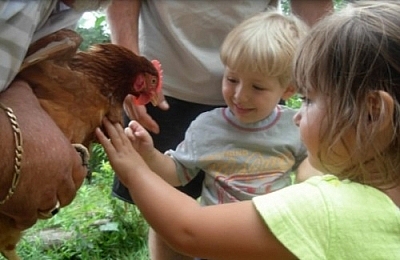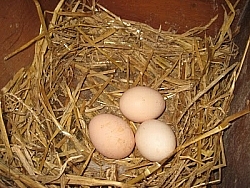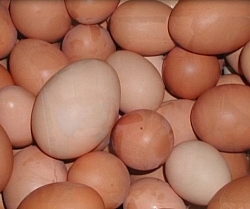Deep in Peru’s Amazon Basin, a hacienda nestles in the rainforest along the shores of the Tambopata River. A covered walkway leads to outer buildings, then transforms into a narrow footpath leading past a banana field, lemon trees, and a vegetable and herb garden. The path ends at an enclosure which engulfs and fences an unseen part of the jungle behind it. Two oscillated turkeys scamper away and disappear into the foliage. To the left, another enclosure is separated by a double shelter — one for the two turkeys, the other for
Picaflor Research Centre‘s chickens.

A wooden ramp leads up to two doors, where the birds are fed. Next to the chickens’ door, accessed from the ground next to the ramp, there is also a large trap door that opens swinging upwards, revealing nests, fresh eggs, and often, chickens still lying on top of them. Picaflor also keeps a rooster, so any of these eggs could hatch if left alone. The hens’ eyes tell me they will protect the eggs fiercely.
I’ve seen chickens on farms before, but it’s been a very long time. Pico, the sole staff member at Picaflor, has sent me to gather today’s eggs while he prepares feed by grinding maize by hand.

I pick the uncovered eggs quickly, pondering how to get to the other ones. Finally, I take off one of my rubber boots and use the softer upper side to nudge the chickens away. I definitely don’t want to hurt them, but I definitely don’t want them to hurt me, either, and I can tell they know I’ve come to get my breakfast.
That was 4½ and a half years ago. Things have changed. A lot. For one thing, I wasn’t vegetarian at the time, so I didn’t care that the eggs were fertilized. And a few seasons ago, I spent an entire summer exchanging farm labour for room and board. No more shooing away laying hens — now they’re my favourite barnyard friends!

Taking care of laying hens is really easy. They like food, water, fresh air, and fresh greens. Hauling the heavy bags of feed is the most challenging part, but taking them out and finding yourself in the middle of a ruckus in the hen house is so much fun. Throw them a couple handfuls of grass and leaves and watch them go nuts.
With 35 hens in my care, I learned that when one looks you in the eye, it probably will peck you, but if it does, it won’t hurt. These guys’ll let you pick ’em up, pet ’em, tousle their feathers, and pat their behinds.

You know that when the animals producing your food are happy, you reap the benefits!
Store-bought eggs taste like water compared to fresh eggs. I’ve heard one reason may be because store eggs can be up to six months old, but I’m convinced it’s also due to the quality of life of battery hens. Fed animal parts, living in their own feces with no room to move, no fresh air, and no greens to snack on, how can such stressed creatures produce healthy food?

Buying organic, cage-free, free run, or free range eggs can cost
$0.20twenty cents to
$0.40forty cents more per egg, but farm-fresh local eggs cost the same as regular store-bought eggs. And more and more we’re hearing about city bylaws changing to accommodate local food production. Many urban dwellers can now join rural residents in choosing to produce their own food.
If finding local eggs is impossible (and it shouldn’t be), try duck eggs from your local food co-op (I’m a member of Eat Local Sudbury). Canadian regulations prevent the sale of uninspected chicken eggs (fresh, local eggs are not usually inspected), but duck eggs may be sold in local food stores.

While I’ve yet to raise my own hens, it’s definitely part of my medium-term plan. Last summer, my parents kept six laying hens to supply our immediate family. My turn will come once I’m out of an apartment!

Still, if my parents decide to raise more hens this year, I may have a few dozen available at the Land of the Voyageurs Farmers Market.
So here’s another way going green can eventually help supplement income, and I’m looking forward to it!











Search Niackery
×